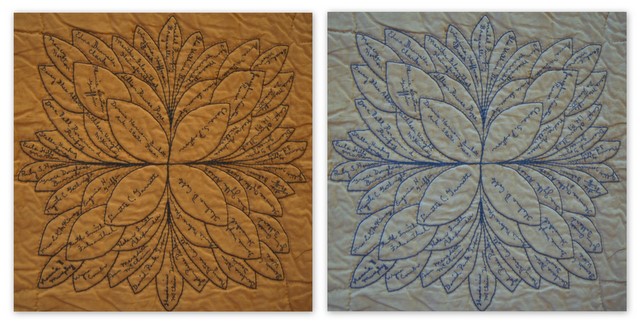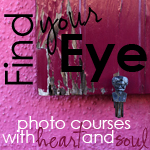Even the simplest solution to a problem in photography is exciting to me. I’m so new to photography that I’ve just barely scratched the surface learning about my first dSLR. I've only had my new camera since June, so I have a long way to go. I know a little about using aperture now and shutter speed, but that’s about it! I'm beginning to shoot more and more in manual, which excites me!!
One of the major problems I have is taking photos inside. At a quilt show I attended I wanted photos of some antique quilts in a very small room with no windows, very horrible incandescent lighting, and no flash allowed. When I took the pictures I felt rather frustrated and disappointed knowing that the pictures would be yellow with the low light. Adjusting for low light is something about my camera I haven't learned yet, so I had to figure out how to correct this problem through post editing. I came home, started playing with how to change the color temperature and to adjust shadows, highlights, and fill light in Picasa. Sounds very simple, but to me it was a huge discovery! I really know very little about editing and have usually shied away from it. I'm one of those that really wants the picture to be right out of the camera, although I know this doesn't always work. I can't control every situation and lighting problem through the camera functions.
 Adjusting the color temperature took out the amber color and I adjusted the fill light just a little. The photo is now more like the actual quilt.
Adjusting the color temperature took out the amber color and I adjusted the fill light just a little. The photo is now more like the actual quilt.
The second quilt presented an additional problem, it was in a glass case. Finding a good position without the glare of overhead lights in the glass was a little challenging. I only adjusted the color temperature on this one.
I was pleased that I was able to salvage photos of the quilts using post editing. There are others photos in my archives that could use a little editing now that I know how. I have been exploring post editing a little more and will use it more often. I'll also be reading and researching more about my camera's functions to correct poor lighting situations.
I was pleased that I was able to salvage photos of the quilts using post editing. There are others photos in my archives that could use a little editing now that I know how. I have been exploring post editing a little more and will use it more often. I'll also be reading and researching more about my camera's functions to correct poor lighting situations.
Another problem I'm need to solve also involves light. When my grandchildren are here, we're always outside in mid-day light or under the shade trees in the dappled light. I'm working on that. I have tried using the fill-flash and that seems to work better, but I need to work on this some more. I just need to spend more time learning about my camera and experimenting with editing!!
A little about the quilts, in case you‘re interested. The first one is a Friendship Quilt which includes major families of Washington, Arkansas and their descendants. Circa 1960 by Mrs. Mildred Butler
The fabric in the second quilt is from civil war uniforms and jackets. The quilt was created before 1901 by Sarah Turner Dawson Bragaw.
This post is linked to Find Your Eye: Journey Of Inspiration with Kat Eye View Of The World


I love Picasa. As another newbie, it makes life so much more fun. I know this sounds silly but the first time I signed my name to a picture I was thrilled. The quilts are beautiful.
ReplyDeleteCathy,
ReplyDeleteHow exciting to follow along on your journey into the world of post-processing. As you have found, editing can come to your rescue when the lighting situation can't be controlled.
One thing you might want to investigate on your camera is the ability to set your white balance - most cameras have presets for the most common lighting conditions - like tungsten and fluorescent. By telling the camera the conditions under which you are shooting,it can often remove the color casts so you have a better chance of getting a successful image SOCC.
I love that feeling when you've managed to save a photo! I've been delving in to post processing too - amazing what you can acheive. I've also taken note of Brenda's comment above and will be experimenting a bit more with what my camera can do - I'm sure I've only really scratched the surface so far. So much to discover! Thank you for sharing. :)
ReplyDeleteThat little tweak to the colour temp has made all the difference.
ReplyDeleteI use Photoshop Elements and have though attending the photography course at college learned to make some post production adjustments, but like you I mush prefer to do it when I am taking the photograph rather than after.
As Brenda said altering the White Balance can help, on my camera I have settings for different lights but also the option to set it manually using a white board (or something white).
I am only just starting to shoot in manual, my aim for this year and am still trying not to use flash as it scares me! I have found that altering the ISO when indoors will often help as well though, and using manual without flash gives me better results than auto with one.
I guess with photography there is always something new to learn! The difference in the first quilt is unbelievable! I love that the second quilt is made from civil war uniforms.
ReplyDeleteWow cool! Love solving problems, makes me know the old brain hasn't frozen up just yet. Thanks for the info on the quilts, fascinating.
ReplyDeleteBrenda,
ReplyDeleteThese quilts are beautiful. I just want to touch the one in the glass case! Light challenges can be a bear, and I'm right there with you learning what these wonderful cameras can do.
I have GOT to get with the post-processing! Seriously!
ReplyDeleteWonderful, Cathy! It can make such a difference. It's great to know what you can correct in post-processing or not, isn't it? What film photographers used to do with filters and other tricks, we can now do in software. One note - if you change the white balance setting on your camera for a specific light, don't forget to change it back or you'll end up with problems later. One other suggestion - if you are shooting through glass try to get up as close to the glass as you can with the camera, touching the glass if possible. This will eliminate the reflections in the glass. Thanks for sharing this great post!
ReplyDeleteVery nice post processing! And I enjoyed learning about the quilts, too.
ReplyDeleteI'm glad you were able to get a truer color to what you remember with the quilts. I have some "yellow" pics myself. I've learned to get around that most of the time with the camera....you will too. June to October is not a long time. Keep practicing. I like to remember that "delete" is a wonderful thing. It allows you too make oodles of mistakes. I found the longer I kept shooting and practicing, the less "deletes" there were, but believe me, there still are plenty.
ReplyDeleteGreat job on fixing the color balance in post processing. It really is amazing the different tools we have at our disposal these days. The quilts you photographed are real treasures. I didn't notice the first time I looked that the friendship quilt had names embroidered into each leaf--talk about a labor of love!
ReplyDeleteYou did a great job in your post processing on the quilts! They are beautiful and it's nice to see them with the lighting adjusted.
ReplyDelete